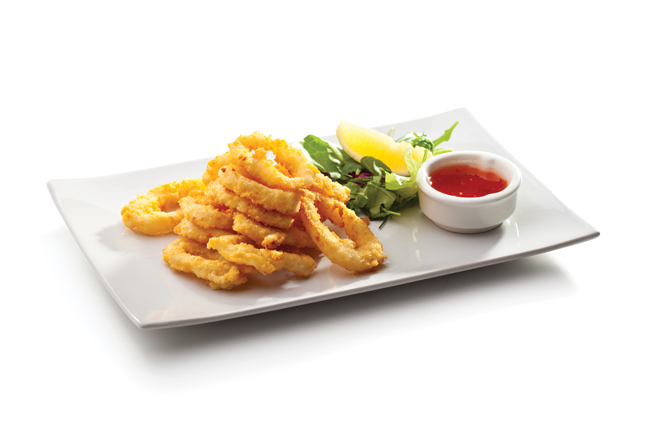The menu will determine the type of fryer that best suits a foodservice operation. Typically, operators use fryers to prepare chicken and fries, but flat-bottom models can accommodate floating products, like fish and seafood.
 Operators can choose from a variety of fryer types and styles, from models geared for general use to multi-purpose and specialty units. In large-volume kitchens operators can opt to place fryers in a battery configuration, with five or six units sitting side by side. This formation allows the operator to employ a single, central filtration system.
Operators can choose from a variety of fryer types and styles, from models geared for general use to multi-purpose and specialty units. In large-volume kitchens operators can opt to place fryers in a battery configuration, with five or six units sitting side by side. This formation allows the operator to employ a single, central filtration system.
Gas, electric, infrared and induction-heated fryers come in either countertop or floor models. Fryer wells come in a variety of widths, from 11 to 34 inches and depths of up to 34 inches. Tank capacities are generally measured by pounds or the maximum oil volume. Although sizes can range from 20 up to 80 pounds, the most common are 14-inch-by-14-inch, which holds 45 to 50 pounds of oil, and 18-inch-by-18-inch, which hold 60 to 80 pounds of oil. Operators with limited footprints and low-volume frying needs may be able to utilize ventless countertop fryers, which offer 2- and 3-pound capacities. The usage of such units, though, is subject to local code.
For high-volume operations pressure fryers cook menu items by using a combination of hot oil and steam. Pressure cooking raises the boiling temperature of the product’s juices without boiling them out of the food item. This may result in a juicier product that’s less greasy when compared to other frying methods.
Operators can choose from three basic fryer configurations. Open-pot designs with heating elements on the tank’s exterior are a popular choice for fries. Tube type units carry gas through pipes located inside the pot, which serve as the heat source. As mentioned above, shallow, square flat-bottom fryers are suitable for more delicate items, like fish.
The more advanced the controls, the tighter the fryer’s variance or tolerance. Fryers offer either dial or computer-controlled thermostats, with the latter automatically turning the fryer on and off for added temperature consistency.
Fryers come with a variety of options that offer different benefits. Central filtration systems can help extend shortening’s service life. Some models provide plumbed filtration systems that allow for draining, filtering and returning shortening to the vat. Fryers with automatic replenishment systems sense when oil is depleted and top it off as necessary. Reduced-oil-volume fryers, also called low-oil-volume fryers, reduce the tank’s oil capacity without changing the fryer’s output. These units can cut oil costs while extending oil life.
Options are available for easier maintenance as well. For example, self-cleaning fryers have stainless steel nozzles that attach to the basket hanger and connect to the plumbing system for easier cleaning of the vat’s interior and fryer’s heat exchanger.
Operators can choose options that help reduce labor and provide more consistent results. With electronic controls, operators receive notice when the preset cook time expires. Automatic lifts raise the baskets out of the cooking oil, halting the cooking process. Automatic basket loaders and unloaders also are available as well as basket shakers that help prevent product from sticking together during the cooking cycle.
A number of energy-efficient fryers are available. Some utilize a blower system that is powered by an electrical motor, which pushes or pulls heat from combustion through the unit. As a result, these fryers are not relying solely on gas pressure to heat the tank’s metal and the shortening. Other models have premix burner systems that accurately mix air and gas for maximum energy efficiency. Fryers with alternative baffling designs rely on the natural vacuum in the tank that, through its exhaust, slowly pulls flames within the unit. There also are models that employ self-cleaning burner systems that perform daily preventative maintenance and keep fryers running at peak efficiency levels.
Standard-sized Energy Star-rated fryers are said to be up to 14 percent more energy efficient, while large vat commercial fryers that are Energy Star rated are up to 35 percent more energy efficient than non-qualified models.



